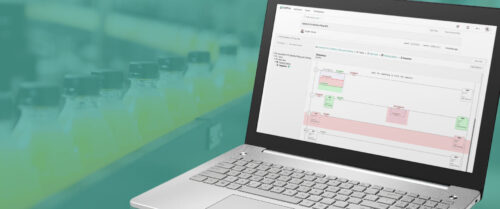DNA for Manufacturing Microsoft Creates Framework for Software Tools
Software vendors have used Microsoft (Redmond, Wa.) tools in myriad ways across many industries. Just as Microsoft used the OLE strategy across industries (OLE for process control, for design and modeling, for the insurance industry…), it now introduces a broader grouping of software technologies, called Microsoft Windows Distributed interNet Applications architecture, or DNA, with ...
KEY WORDS
Software for control
Microsoft
Distributed computing
Internet
Database
Sidebars: Rockwell Automation’s RNA continues genetic building block analogy for control Windows 2000 will emphasize ease of use Key Windows 2000 Features
Software vendors have used Microsoft (Redmond, Wa.) tools in myriad ways across many industries. Just as Microsoft used the OLE strategy across industries (OLE for process control, for design and modeling, for the insurance industry& ), it now introduces a broader grouping of software technologies, called Microsoft Windows Distributed interNet Applications architecture, or DNA, with a subset, DNA for Manufacturing (DNA-M), scheduled to launch later this month.
The DNA effort eventually may quiet the cacophony of incompatible software languages linking to and through manufacturing and process control into business systems and back again.
DNA structure provides a standard model and toolset to link various layers of software in standard ways like its biological building-block acronym, DNA, suggests. For manufacturing, that translates into a seamless environment ‘from shop floor through enterprise resource planning systems,’ according to Microsoft.
Microsoft’s partners in manufacturing have quietly been talking about DNA since June 1998 and have been using various DNA components for several years. DNA packages multiple scalable, client/server tools, such as ActiveX, Basic and Dynamic HTML, SQL Server, Visual Basic for Applications, and more, in an understandable framework with COM serving as the glue. (See DNA diagrams.) Microsoft’s first industry introduction of DNA was for financial services as DNA-FS.
Microsoft Windows DNA (Distributed interNet Applications) architecture is a framework of services in three tiers for distributed applications: user interface and navigation, business processes, and storage.
With DNA-M, Microsoft is ‘trying to make application integration a lot easier,’ explains Marcus Schmidt, Microsoft industry marketing manager for manufacturing, Application Developer Customer Unit.
DNA-M will allow better use of existing technologies, such as recently released SQL Server 7.0, a Windows NT-based relational database. DNA tools span all three layers user interface and navigation, business processes, and integrated storage.
Using DNA-M will allow Microsoft manufacturing partners to have time to develop more market-specific applications. Just as users buy best-of-breed hardware components for desktop units, DNA-M will permit users to buy software applications from different vendors, avoiding a single vendor lock on customers. While multivendor interoperability across levels will increase, ‘we’re probably not at plug-and-play nirvana yet,’ Mr. Schmidt says.
‘Integrating manufacturing applications has been a struggle for users. I view DNA-M as a key enabler for the digital nervous system, allowing information to flow smoothly from the factory floor into the ERP system and back in a seamless fashion,’ he says. DNA-M helps ‘fill the gaps between apps,’ helping to ensure a level technical playing field for software vendors, although users are still likely to require some integration.
No verification or compliance requirements are planned at this point for vendors using DNA-M technologies, Mr. Schmidt explains. A vendor doesn’t have to incorporate a certain number or combination of DNA component tools to say it uses the DNA-M framework just select what are most applicable for customers. While Microsoft will continue to enhance DNA-M building blocks, it maintains its stance of not producing application software for manufacturing.
Manufacturing companies expected to participate at the Feb. 23 and 24 launch of DNA for Manufacturing include Baan (Reston, Va.), Camstar (Campbell, Calif.), Compaq’s Digital business (Maynard, Mass.), Groupe Schneider (North Andover, Mass.), Intellution (Norwood, Mass.), Rockwell Automation (Milwaukee, Wis.), SAP (Walldorf, Germany), USDATA (Richardson, Tex.), Wonderware (Irving, Calif.), among others.
Microsoft Windows DNA for Manufacturing is a system-wide architecture for allaspects of the business, connecting the plant-floor devices with automation,control, and process applications, through enterprise resource planning systems.
Applications: tires, sweetener
Users have been employing DNA-M technologies in various applications, creating a fast-response ‘digital nervous system,’ Schmidt says.
Bridgestone/Firestone (Nashville, Tenn.) uses DNA technologies within Intellution’s Fix Dynamics software and Microsoft BackOffice, gathering information from various controllers, OPC clients and servers, for a new facility in Aiken, S.C., due online April 1999.Bridgestone/Firestone customized and deployed the solution in 85% less time compared to a predecessor, according to senior electrical engineer, Gary Larson. Mr. Larson estimates integration cost savings of 60%, in part by using the ‘highly intuitive’ Microsoft Visual Basic for Applications toolkit.PCs using Windows NT communicate with multiple PLCs in production and material routing for the plant, expected to employ 800 and produce tens of thousands of tires daily. Anticipated operating advantages include higher quality control, easier maintenance, real-time process changes, and ‘dramatic’ reductions in work-in-process inventories. ‘Being able to drop in ActiveX controls was very beneficial,’ Mr. Larson says, ‘allowing SQL Server to initiate communications with Fix Dynamics.’
Saturn Corp. (Spring Hill, Tenn.) is using GE Fanuc’s (Charlottesville, Va.) Cimplicity for production management and in paint booths, with Windows CE in hand-held computers tied to the process control system. Downloading information to computers running SQL Server allows analysis that results in process adjustments faster than previously allowed.
Pennzoil Co. (Houston, Tex.) analyzes performance using SAP R/3 ERP software and the new SQL Server 7.0, introduced mid-November 1998.
Cumberland Packing Corp. (Brooklyn, N.Y.) which produces Sweet ‘N Low, resolved Y2K issues and inventory challenges with Adage from SCT Corp. (Malvern, Pa.). Adage is an object-oriented, graphical ERP software for process and hybrid industries. The system was live in five months, compared to years for other ERP solutions. Installation included a wide-area network under Microsoft Windows NT Server and Citrix WinFrame. Inventory on hand fell 10-15%, or about $2 million, delivery lead times fell, and customer service improved, as did demand planning and forecasting.
Mr. Schmidt says development of DNA-M came with input from Microsoft partners and their customers. ‘We had feedback that OPC wasn’t enough to ensure interoperability many applications beyond the shop-floor level required attention within the manufacturing ecosystem. DNA for Manufacturing brings together existing technologies, providing long-term direction. In the past, we’ve had many useful tools, but no one ever understood how they all fit together; Windows DNA slots different Microsoft technologies into a framework,’ Schmidt says.
Object model important
Several of Microsoft’s manufacturing partners agreed. George Lo, R&D engineering manager for Siemens industrial software business unit, says ‘Microsoft is forging a formidable architecture which, as technologies behind DNA are maturing and becoming industrial strength, will provide the framework for building future distributed auttomation systems. The idea of three-tier architecture is not new, but the object model within is important.’
Dr. Lo says the ActiveX Data Object abstraction layer over OLE BD (a Microsoft low-level data interface) allows the application to be independent from the type of data source or how the data is stored. Enabling technology includes use of web clients and servers.
‘Standardization makes life easier and more productive,’ adds Siemens’ Dr. Lo. ‘In the past, we needed to do a lot of engineering work on the basic architecture and technology; now we can concentrate on the task of providing automation for customers.’
Dr. Lo thinks Microsoft’s use of Internet technologies ‘gives users a whole new means to transform the way of doing automation. We need to look at these very closely and complement them when necessary.’
Brian Daleiden, Microsoft Strategic Alliance Manager, Rockwell Automation, suggests Microsoft DNA framework approaches the ‘holy grail’ of manufacturing information technology a seamless, cost-effective, scalable, and future-proof system to bring information up from the factory floor and distribute it throughout the enterprise. ‘Microsoft’s DNA for Manufacturing architecture combined with Rockwell Automation’s experience in plant-floor control and information management will help make shop floor to top-floor integration a reality.’ (See ‘Building Blocks’ sidebar.)
In addition to technologies described, other vendors using DNA-M technologies include Aspen Technologies’ (Cambridge, Mass.) Plantelligence process industries software for smart manufacturing and supply chain management; Groupe Schneider’s Transparent Factory open automation framework enhances user information access in devices such as PLCs, installed I/O, and workstations; and USDATA, whose FactoryLink ECS 6.6 a real-time application server product connects plant-floor devices, consolidates and processes data, and communicates throughout the enterprise using OPC client and server support.
Rockwell Automation’s RNA continues genetic building block analogy for control
Using core Microsoft Windows DNA (Distributed interNet Applications) architecture technologies, Rockwell Automation (Milwaukee, Wis.) created a platform for interoperability called RNA (Rockwell interNet Applications) for use among its own suite of Rockwell Software industrial software and Allen-Bradley automation control products.
Brian Daleiden, Microsoft Strategic Alliance Manager, Rockwell Automation, says ‘RNA leverages COM, DCOM, and VBA to allow interoperability with other plant-floor software applications, and also serves as the basis for the Rockwell Software ProcessPak and ControlPak solutions aimed at process control and PC-based control applications.’
Daleiden adds, ‘ProcessPak and ControlPak integrate such functions as human-machine interface, control, database transaction management and batch processing into an integrated package, providing a large subset of the DNA architecture in one software product.’
Windows 2000 will emphasize ease of use
Microsoft Windows 2000 (formerly NT 5.0) will focus on user simplicity, making the operating system easier and more approachable, without need to spend a lot of time on maintenance.
The next release in the Windows NT family will make integration of applications easier, so users can focus on the business and not the technology, explains Marcus Schmidt, Microsoft industry marketing manager for manufacturing, Application Developer Customer Unit. (See Windows 2000 table.)
George Lo, R&D engineering manager for Siemens industrial software business unit, says Microsoft intends to make Windows 2000, formerly Windows NT 5.0, its ‘first non-point-zero release. In the past, we’ve really had to wait for the point-one version before it was reliable enough for industrial operations. This, as I understand, will be a fairly well-tested operating system.’
Windows 2000 will emphasize plug-and-play capability, simplify configuration and network management, and improve security. It will be a better operating system for distributed, industrial solutions, Dr. Lo suggests.
Siemens released PC-based control with a native Windows 4.0 solution, Simatic WinAC, last year. Marcus Boerkei, marketing manager for Siemens PC-based control, expects smooth migration from Windows 4.0 to Windows 2000.
Mr. Boerkei says, ‘Within a decentralized and distributed environment, application size or location shouldn’t make a difference. We are looking into centralized configuration and programming environment for the distributed solution.’
Key Windows 2000 Features
Key features in the Beta 2 version of Microsoft Windows 2000 Server include:
Manageability, through Active Directory service, Microsoft Management Console, Group Policy Editor, and Application Installation Service;
Setup and troubleshooting tools, with Advanced System Recovery, hard-disk duplication, Driver Incompatiblity Wizard;
Storage management&file system, with automatic monitoring of hard-disk space, application sharing of libraries and drives, encryption support, and enhanced backup;
Application services, with Transaction Services and Web Application Services;
Information sharing and publishing to publish and share information over the web;
Print server services, with more flexibility and support;
Scalability and availability, with Enterprise Memory Architecture, improved scalability, use of Job Objects, Clustering Services, TCP/IP enhancements, and I2O Support to relieve the host of interrupt-intensive I/O tasks;
Increased security; and
Networks and communications improvements.
Do you have experience and expertise with the topics mentioned in this content? You should consider contributing to our CFE Media editorial team and getting the recognition you and your company deserve. Click here to start this process.





